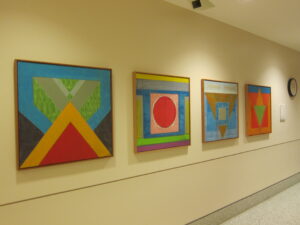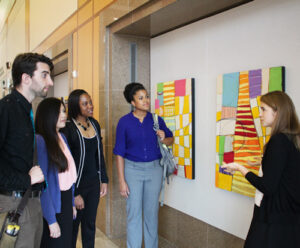
Untitled, 1991; Gold Triangle, 1991; Setting Sun, 1990; One of Three, 1989, acrylic on canvas
ARTIST STATEMENT
My art career began when Abstract Expressionism was recognized as the new American Art. Exhibitions at New York galleries made a lasting impression— to make a visual conceptual statement. Over the years, I have traveled to understand how artists perceive life in their time and have seen original art collections in historical context in Europe, England, Scandinavia, Mexico, Central America, and at regional US art centers. I have considered how my art-making would be influenced by masters of perception.
My art direction is to make artifacts from imagination and recall. I focus on completion and the way through it. To begin with, the draughtsman-painter works on a two-dimensional surface. The artist envisions an imaginative experience through which personality dictates how a composition is completed. For example, although three representative artists may be in the same viewing position to render a landscape or figurative subject, the completed art works are different. The difference can be style— photo-likeness, impressionism, or abstraction. A critic may note differences in the artist’s temperament, an alliance with social issues, or a challenge to the avant-garde of the time—the art of the new.
There can be no objective conclusion, except that all art making is subjective. Ultimately, distinctions are based on individual creations as a “body of work”—foreground-background, perspective, modeling, outlined shapes, light and color tonal gradations and the path of the viewer’s eye over a two-dimensional surface.
My artwork is original. I do not copy or draw from human figures or landscapes. I make a series of abstract line drawings within a square or rectangle ratio. When I like some of the drawings, I select one and “scale-up” the line drawing by projecting it onto a stretched canvas of the same ratio, secured to an easel. Then the work begins. My intention is to solve a problem. I have no specific idea when I will decide that the art work is completed. It is an intuitive process. Sometimes it will take a long time to make decisions. That is why I generally make more than one painting at a time (with different image compositions). In this way, I like to think I am creating original artifacts in the spirit of my time.
ARTIST BACKGROUND
Jack Martinelli received his MFA from George Washington University and has shown his work nationally and internationally since 1956. Mr. Martinelli has artwork in the public collections of George Washington University Medical Center, Washington, DC; The National Museum of Catholic Art and History, New York, NY; and The Marvin S. Schapiro Collection, Baltimore, MD. During his career, Mr. Martinelli has collaborated with the Arlington Arts Center and the Greater Reston Arts Center.
Permanent Art Collection of the NIH Clinical Center, for more information contact the Office of Space and Facility Management, 301 496-2862.




Jan
12